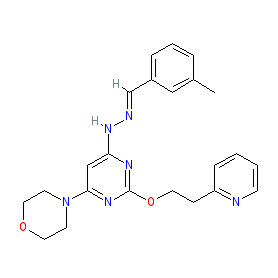GtoPdb is requesting financial support from commercial users. Please see our sustainability page for more information.
|
Synonyms: LAM-002A (apilimod dimesylate) | LAM002A | STA 5326 | STA-5326 | STA5326
Compound class:
Synthetic organic
Comment: Apilimod was originally identified as an inhibitor of IL-12/IL-23 production [12], but the molecular mechanism behind this biological effect was undetermined. Inhibition of IL-12/IL-23 production has application for the treatment Th1-and Th17-mediated immunologic pathologies (which are driven by IL-12 and IL-23 respectively) [11-12]. Apilimod has subsequently been identified as a selective inhibitor of the type III phosphoinostol kinase, PIKfyve [4-5].
We provide structural details for the parent molecule, but some bioactivity data may relate to use of the mesylate salt form as stipulated by the compound's USAN (see PubChem CID 115273300). PIKfyve has been reported as being required for Ebola virus (EBOV) infection of host cells [9], and indeed apilimod has anti-EBOV activity in vitro. More broad-spectrum antiviral activity against Lassa virus (LASV), Marburg virus (MARV) [8] and SARS-CoV-2 [6,10] is supported in the literature. Activity of PIKfyve is markedly modulated by SARS-CoV-2 infection in vitro, and indicates potential hijacking of phosphatidylinositol enzyme activities by the coronavirus [3]. Pharmacological inhibition of this kinase with apilimod has anti-SARS-CoV-2 activity in two model cell lines, A549-ACE2 cells (IC50 7 nM) and Vero E6 cells (IC50 80 nM), and in human iPSC-derived pneumocyte-like cells Ligand Activity Visualisation ChartsThese are box plot that provide a unique visualisation, summarising all the activity data for a ligand taken from ChEMBL and GtoPdb across multiple targets and species. Click on a plot to see the median, interquartile range, low and high data points. A value of zero indicates that no data are available. A separate chart is created for each target, and where possible the algorithm tries to merge ChEMBL and GtoPdb targets by matching them on name and UniProt accession, for each available species. However, please note that inconsistency in naming of targets may lead to data for the same target being reported across multiple charts. ✖ |
|
|||||||||||||||||||||||||||||||||||
| References |
|
1. Baranov MV, Bianchi F, Schirmacher A, van Aart MAC, Maassen S, Muntjewerff EM, Dingjan I, Ter Beest M, Verdoes M, Keyser SGL et al.. (2019)
The Phosphoinositide Kinase PIKfyve Promotes Cathepsin-S-Mediated Major Histocompatibility Complex Class II Antigen Presentation. iScience, 11: 160-177. [PMID:30612035] |
|
2. Baranov MV, Bianchi F, van den Bogaart G. (2020)
The PIKfyve Inhibitor Apilimod: A Double-Edged Sword against COVID-19. Cells, 10 (1): 30. [PMID:33375410] |
|
3. Bouhaddou M, Memon D, Meyer B, White KM, Rezelj VV, Marrero MC, Polacco BJ, Melnyk JE, Ulferts S, Kaake RM. (2020)
The Global Phosphorylation Landscape of SARS-CoV-2 Infection. Cell, Article Online Now. DOI: 10.1016/j.cell.2020.06.034 |
|
4. Cai X, Xu Y, Cheung AK, Tomlinson RC, Alcázar-Román A, Murphy L, Billich A, Zhang B, Feng Y, Klumpp M et al.. (2013)
PIKfyve, a class III PI kinase, is the target of the small molecular IL-12/IL-23 inhibitor apilimod and a player in Toll-like receptor signaling. Chem Biol, 20 (7): 912-21. [PMID:23890009] |
|
5. Gayle S, Landrette S, Beeharry N, Conrad C, Hernandez M, Beckett P, Ferguson SM, Mandelkern T, Zheng M, Xu T et al.. (2017)
Identification of apilimod as a first-in-class PIKfyve kinase inhibitor for treatment of B-cell non-Hodgkin lymphoma. Blood, 129 (13): 1768-1778. [PMID:28104689] |
|
6. Ianevski A, Yao R, Fenstad MH, Biza S, Zusinaite E, Reisberg T, Lysvand H, Løseth K, Landsem VM, Malmring JF et al.. (2020)
Potential Antiviral Options against SARS-CoV-2 Infection. Viruses, 12 (6). [PMID:32545799] |
|
7. Logue J, Chakraborty AR, Johnson R, Goyal G, Rodas M, Taylor LJ, Baracco L, McGrath ME, Haupt R, Furlong BA et al.. (2022)
PIKfyve-specific inhibitors restrict replication of multiple coronaviruses in vitro but not in a murine model of COVID-19. Commun Biol, 5 (1): 808. [PMID:35962188] |
|
8. Nelson EA, Dyall J, Hoenen T, Barnes AB, Zhou H, Liang JY, Michelotti J, Dewey WH, DeWald LE, Bennett RS et al.. (2017)
The phosphatidylinositol-3-phosphate 5-kinase inhibitor apilimod blocks filoviral entry and infection. PLoS Negl Trop Dis, 11 (4): e0005540. [PMID:28403145] |
|
9. Qiu S, Leung A, Bo Y, Kozak RA, Anand SP, Warkentin C, Salambanga FDR, Cui J, Kobinger G, Kobasa D et al.. (2018)
Ebola virus requires phosphatidylinositol (3,5) bisphosphate production for efficient viral entry. Virology, 513: 17-28. [PMID:29031163] |
|
10. Riva L, Yuan S, Yin X, Martin-Sancho L, Matsunaga N, Pache L, Burgstaller-Muehlbacher S, De Jesus PD, Teriete P, Hull MV et al.. (2020)
Discovery of SARS-CoV-2 antiviral drugs through large-scale compound repurposing. Nature, [Epub ahead of print]. DOI: 10.1038/s41586-020-2577-1 |
|
11. Wada Y, Cardinale I, Khatcherian A, Chu J, Kantor AB, Gottlieb AB, Tatsuta N, Jacobson E, Barsoum J, Krueger JG. (2012)
Apilimod inhibits the production of IL-12 and IL-23 and reduces dendritic cell infiltration in psoriasis. PLoS ONE, 7 (4): e35069. [PMID:22493730] |
|
12. Wada Y, Lu R, Zhou D, Chu J, Przewloka T, Zhang S, Li L, Wu Y, Qin J, Balasubramanyam V et al.. (2007)
Selective abrogation of Th1 response by STA-5326, a potent IL-12/IL-23 inhibitor. Blood, 109 (3): 1156-64. [PMID:17053051] |








